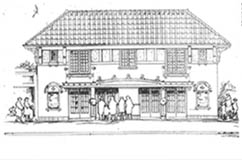Fitzherbert Leather was born in London where his father was a builder and he apprenticed as a mason and blacksmith. After immigrating to Aberdeen, Washington he moved to Seattle where he worked on the Romanesque Revival Bailey Block in Pioneer Square as a masonry designer for the architectural frim of Saunders & Houghton. He remained associated with the architects and in particular Edwin Houghton who was also British. Houghton became known for his theater designs (over 37 70 theaters in North America). Houghton's towering influence apparently spun off on young Fitzherbert whose career in the building trades also crossed paths with wealthy building contractor  Matthew Dow. In 1913 Fitzherbert Leather left Saunders & Houghton and began practicing architecture in Seattle. He married Dow's daughter just before the First World War and reportedly he soonwas working on his father-in-law's projects. Leather also published a plan book in 1917 for one story school houses. The 56 page guidebook was published by the National Lumber Manufacture's Association in Chicago, but it unknown if any of the designs were executed. Leather's known projects include the Blue Mouse Jr. (1923), his only Tacoma commission, and the plans for the reconstruction of the burned out Everett Theater (1924). Soon after, Leather drifted into advertising and finance and eventually away from architecture entirely. Leather died in Sedro Woolley on November 30, 1958.
Matthew Dow. In 1913 Fitzherbert Leather left Saunders & Houghton and began practicing architecture in Seattle. He married Dow's daughter just before the First World War and reportedly he soonwas working on his father-in-law's projects. Leather also published a plan book in 1917 for one story school houses. The 56 page guidebook was published by the National Lumber Manufacture's Association in Chicago, but it unknown if any of the designs were executed. Leather's known projects include the Blue Mouse Jr. (1923), his only Tacoma commission, and the plans for the reconstruction of the burned out Everett Theater (1924). Soon after, Leather drifted into advertising and finance and eventually away from architecture entirely. Leather died in Sedro Woolley on November 30, 1958.
Adapted from NR nomination for Blue Mouse Jr. Theater - by Brooke Manning





